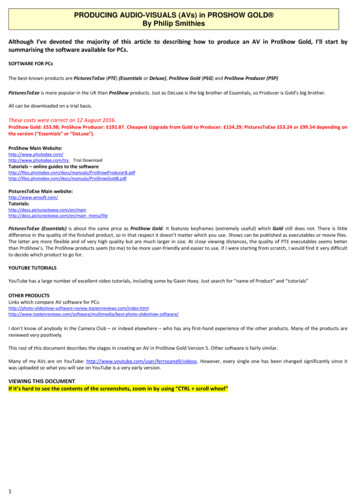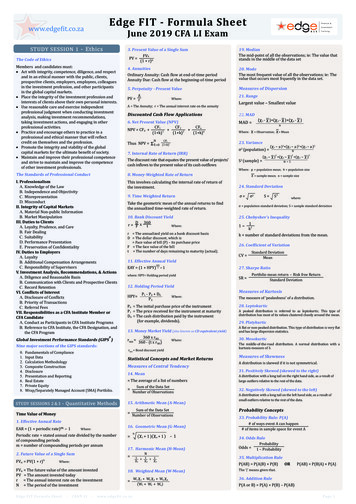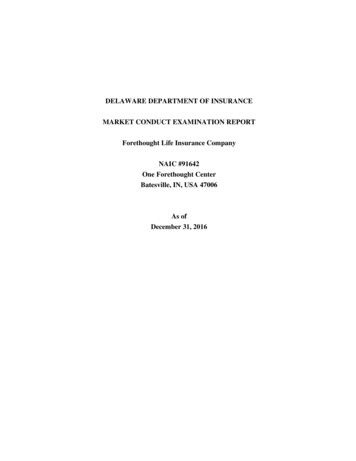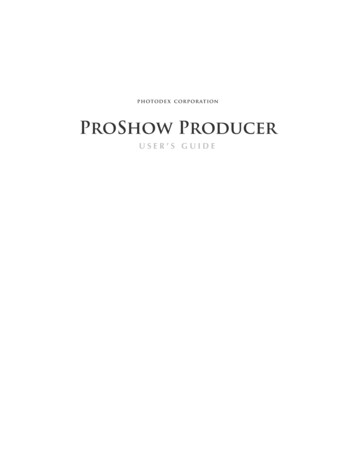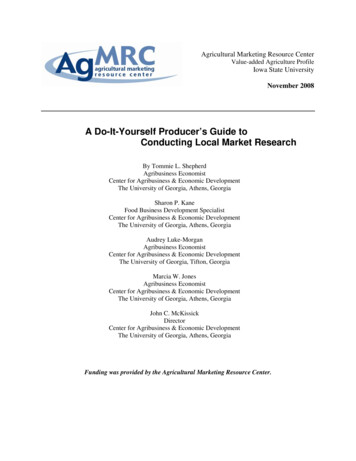
Transcription
Agricultural Marketing Resource CenterValue-added Agriculture ProfileIowa State UniversityNovember 2008A Do-It-Yourself Producer’s Guide toConducting Local Market ResearchBy Tommie L. ShepherdAgribusiness EconomistCenter for Agribusiness & Economic DevelopmentThe University of Georgia, Athens, GeorgiaSharon P. KaneFood Business Development SpecialistCenter for Agribusiness & Economic DevelopmentThe University of Georgia, Athens, GeorgiaAudrey Luke-MorganAgribusiness EconomistCenter for Agribusiness & Economic DevelopmentThe University of Georgia, Tifton, GeorgiaMarcia W. JonesAgribusiness EconomistCenter for Agribusiness & Economic DevelopmentThe University of Georgia, Athens, GeorgiaJohn C. McKissickDirectorCenter for Agribusiness & Economic DevelopmentThe University of Georgia, Athens, GeorgiaFunding was provided by the Agricultural Marketing Resource Center.
IntroductionA Producer’s Guide to Conducting Local Market ResearchIntroductionMany producers of agricultural commodities investigate the potential for developing value-added products each year as a means of enhancing income from their farming operations, capturing niche markets for locally grown food products or developing new markets for products that spring from their own innovative ideas. Theseproducers often lack both the technical skills necessary to conduct meaningful market research and the resources to hire professional consultants. University Extensionprograms frequently offer some level of assistance in these areas but often lack thetime and industry specific knowledge to guide producers through in-depth studiestailored to individual products or markets.Value-added outreach and educational programs are typically designed to present general information to groups of producers withdiverse product interests, and as such, onlydiscuss market research in very generalterms, and then only as part of a broadercurriculum.Interest in value-added agriculture hasGrowing interest in specialty food products has sparked a waveof food contests such as this one in Atlanta, Georgia showcas- grown considerably over the past severaling local products from some of the state’s food entrepreneurs.years, especially as it relates to direct marketing of local, value-added and specialty food products. In response to this growing interest, numerous how-to guides have been published on the subject of marketing locally produced food products, starting food businesses and evaluating localmarkets. These publications tend to be directed toward producers who often havelittle or no technical knowledge of marketing or starting a food business and tend tobe quite general in nature.1
IntroductionA Producer’s Guide to Conducting Local Market Research“A Producer’s Guide to Conducting Local Market Research” focuses on onlyone area of food business development. It seeks to provide the reader with a concise guide that explains clearly, in layman’s terms, how producers can go aboutconducting their own quantitative market research at a local, state or regionallevel. It will instruct those interested in developing markets for value-added agricultural products, but lacking an in-depth knowledge of quantitative analyticalmethods or the resources to hire professional consultants, in how to collect andanalyze local level data anddraw conclusions relevantto product positioning, pricing and supply/demand determination. It will instructreaders, both conceptuallyand through use of casestudy examples, as to whatmarketing research is andwhy it is important to Many publicly available sources of food consumption data such asthe USDA Economic Research Service’s Food Availability DataSystem offer a wealth of free information to producers willing toinvest time and effort in conducting market research.re-search has historically been the territory of professional researchers with backgrounds in statistics, economics or mathematics. This guide offers a comprehensive tutorial, presented in layman’s language, that explains the concepts behindmarket research that are used by large firms, as well as how these concepts maybe translated to a local level. It will discuss collecting and analyzing readily available, local-level data, thus providing producers with important research that otherwise might be unattainable, while simultaneously educating producers aboutthe markets they are considering entering and providing them with the back-2
A Producer’s Guide to Conducting Local Market ResearchIntroductionground and confidence to comfortably discuss the market research component of theirbusiness plan with potential lenders or investors.With the development of user-friendly spreadsheet software such as Microsoft Excel,which has the capability to reduce complicated calculations to the click of a mouse, andthe ready availability of enormous amounts of demographic and consumption data viathe Internet, this no longer has to be the case. It is now well within the capability of theaverage producer to conduct his or her own local market research by applying simplifiedversions of the same procedures used by professionals. The following chapters willguide producers through the process of actually collecting local-level data from available sources such as grocery store shelves, newspaper advertisements, restaurantmenus, farmers' markets and food service institutions. It will take the producer, step-bystep, through organizing the data they have collected in electronic spreadsheet formatand offer simple, concise, Microsoft Excel based solutions that will assist them in determining which local markets are the best fit for their product, how it should be positionedand priced in the market and what realistic estimates of the demand for their productmay be.Empowering individual producers to clearly understand and conduct market researchthat is specific to their individual product and local market will provide significant benefits to those considering or expanding some type of value-added agricultural enterprise.This instruction will assume little or no prior knowledge of marketing, market researchor quantitative methods. The following publication is geared very specifically toward asingle subject: market research. It does not attempt to address such subjects as whatproduct one should choose to produce or how he or she should produce it. It does notbroach the subject of financing the business enterprise or what business model may beappropriate. Numerous publications exist to educate readers on these subjects. Likewise, it does not presume to instruct the reader how to construct a feasibility study orwrite a business plan, although the results of market research efforts typically comprise an important component of both feasibility studies and business plans.3
Chapter1A Producer’s Guide to Conducting Local Market ResearchWhat is Marketing Research andHow Can It Benefit Local Producers?A Producer’s Guide to Conducting Local Market ResearchToday’s consumer is faced with an enormous array of food choices. Although themajority of food is still purchased in some type of retail outlet and consumed athome, an ever increasing number of meals are consumed away from home in restaurants ranging from fast food chains to upscale establishments. Food retailers haveevolved from small, locally owned and operated grocery stores to supermarkets, super stores, warehouse stores and hypermarts. This evolution in store size has beenaccompanied by an explosion in both the type of products that are available and thevariety of permutations of each type of product. Consider, for example, that a generation ago consumershad the choice of buying Coca-Cola or Pepsi Cola.Today they may choose from Coca-Cola, Diet Coke,Caffeine-Free Cola-Cola, Coca-Cola Cherry, CocaCola with Lemon, Coca-Cola Raspberry and CocaCola Zero, to name a few. Pepsi offers a similarlydaunting set of choices. In addition to these twodominant soft drink firms, literally dozens of smallerToday’s consumer faces an enormous array of competitors exist, including store brands, private lachoices as shown by this selection of specialtydairy products. Where will your product fit in? bels and “boutique” colas. These same conditionscan be observed for everything from alphabet soup to zucchini dip. In recent years,many of these categories have been expanded to include varieties that are labeled as“all natural,” organic or “made with organic ingredients” as well.Consumers need not, however, limit their shopping to supermarkets. Additional options include convenience stores, drug and general merchandise stores,1
A Producer’s Guide to Conducting Local Market Researchfarmers' markets, road side stands and “pick your own” establishments, to name a few.Chapter1A Producer’s Guide to Conducting Local Market ResearchThis dizzying array of options presents both a tremendous opportunity and a significantchallenge to local producers of all kinds of food products who dream of profiting from developing and marketing their own creations. The opportunity arises from a market whichhas conditioned consumers to expect an ever broadening array of choices and to seekout varieties of products that are closely matched to their tastes. It has also conditionedthem to seek high quality and convenience in the form of pre-prepared or partially prepared foods that fit into busy lifestyles that leave less and less time for meal preparation.The challenge arises from the difficulty in identifying gaps in the extensive lineup ofalready available products and developing and marketing a new product, or variation of anexisting one, that fills that gap. Meeting this challenge is the role of market research.Would-be food entrepreneurs typically fall into one of two categories. One is the producerwho has a very specific idea or prototype of a product and needs to assess the most effective way to sell it. A common example of this entrepreneur is the individual who believes that he or she possesses the recipe for the world’s absolute best barbeque sauce,wine, cheese, etc. and wishes to discover the most effective way to go about marketing it.The second type of entrepreneur is one who produces a raw product such as tomatoes,grapes, or milk and desires to pinpoint the most profitable method for adding value to hisor her raw product. Their research may, therefore, not be limited to answering questionsabout the best way to market cheese, but whether milk should be processed into cheese,butter, ice cream or simply bottled and sold in its original form.The Johnston Dairy StoryJohnston Dairy began operations in the 1940s and followed the model ofmost dairies in the U.S. by selling its milk through a farmer-owned cooperative. Johnston’s milk was delivered to a large corporate dairy processor whocommingled it with the milk of many similar dairies and marketed it under anumber of well-known brands and store labels. The second generation ofJohnston dairy farmers became interested in capitalizing on the growing interest in locally produced foods and began to research the idea of launchinga family brand in 2005. The quest to determine whether the venture couldbe financially feasible led dairyman Russell Johnston through a series ofsteps involving analysis of customer perceptions of currently availablemilk products, desired attributes such as container types, fat content, flavorand shelf life, as well as their willingness to pay a premium for his product.2
A Producer’s Guide to Conducting Local Market ResearchIn each case, the producer faces the reality of introducing a new, and as yet untried,A Producer’s Guide to Conducting Local Market ResearchChapter1product into a marketplace filled with dozens, or hundreds, or maybe even thousands ofcompeting products. Many difficult questions must be asked and answered as part ofthe evaluation process. What attributes, for example, will the new product have to offerthat are not already available in the marketplace? Consider the previous example ofcheese. Will the hopeful cheese maker be able to produce a product that is so superiorin quality to the finest award-wining cheese currently available that it will command apremium price and draw cheese connoisseurs away from their current favorite? Or, willhe be able to produce a generic cheddar at a cost so low, and in quantities so large, thathe can compete on price with the most efficient cheese plants? The likely answer toeach of these questions is no. So, where will our would-be cheese maker’s product fitin?This is where the value of market research becomes evident. Carefully conductedmarketing research may help to establish whether there is a market for a cheese productwith a particular flavor, texture, form or packaging attribute. It can help to establishwhether consumers of the finest gourmet cheeses will “trade down” to an “almost gourmet” cheese at a slightly lower price, or whether buyers of lower priced generic cheddarwill pay more for a small improvement in taste.For any given product, there may exist an almost infinite number of combinations ofprice, taste, packaging, convenience and perceived health attributes such as all natural,organic or hormone free. Marketing research offers a set of well defined and generallyaccepted methods for identifying which combination may have the greatest likelihood ofsuccess. While almost all, if indeed not all, food products face competition from substitutes at some level, competition is certainly more fierce among some products than others. The home chef who believes that he has truly created the world’s tastiest barbequesauce will almost certainly face many more close competitors than the entrepreneur whoseeks to make his fortune marketing belachan. Both face unique challenges. While thebarbeque sauce maker may face hundreds, if not thousands, of close competitors, he3
A Producer’s Guide to Conducting Local Market ResearchChapter1A Producer’s Guide to Conducting Local Market ResearchThese local barbeque sauces certainly present an interesting lineup, but the real question is who will buy them?stands to benefit from marketing a widely accepted product. The typical shopper has atleast heard of barbeque sauce!Large, established companies, including food manufacturers, typically expend considerable resources conducting marketing research, either through their own internalresearch departments or by contracting with outside research firms. Individual producers attempting to launch their own value-added products will usually lack the resourcesnecessary to hire outside marketing research firms and quickly realize that they aretheir company’s research department, whether they desire to assume thoseresponsibilities. Among these responsibilities is the need to develop ways tomonitor their customers. Smart consumer goods companies usually approach productdevelopment by examining their customers’ needs and engineering products that meetthose needs. Successful examples of this approach include automobiles with foldingrear seats to provide extra storage space, on-board navigation and entertainment systems to occupy children on long trips. Home computers have become far more commonplace with the development of Windows-based operating systems, pre-installed softwareand the ubiquitous mouse. Even the lowly coffee maker has been re-engineered with features that allow the user to wake up to a fresh cup of his favorite brew, made fromfreshly ground beans and programmed to be ready at the time of his choosing. While itis true that most raw food products cannot be easily re-engineered, the opportunity exists for adapting them to the consumer’s preference for taste, health attributes, convenience, ease of preparation and so on.4
A Producer’s Guide to Conducting Local Market ResearchTaking advantage of this opportunity begins with asking questions such as why a con-A Producer’s Guide to Conducting Local Market Researchsumer chooses to purchase, or not purchase, a particular product. The aspiring entrepre-Chapter1neur must assess whether the customer who would eagerly consume the fruits of his labor has the opportunity to purchase it conveniently and at a competitive price and has thetime and know how to prepare it. It is important to remember that the consumer who mightthoroughly enjoy a Thanksgiving dinner of turkey, roasted chestnuts and pumpkin piemay no longer possess the knowledge of how to dress a free-range turkey, prepare chestnuts or peel a pumpkin, let alone mix the half dozen or so spices necessary to make a piethat tastes just like Grandma’s. In most cases the producer will be much more familiarwith his product than are his customers, and having this knowledge, will find it incrediblethat everyone else does not. For this reason, producers should rely on solid research andnot their own personal experience or intuition in marketing a product. One interesting example of this is the dairy farmer who, accustomed to drinking un-homogenized milk, wasdisappointed that no one seemed to want to buy his fresh milk bottled directly from thesource. Imagine his dismay upon learning that potential customers, unfamiliar with unhomogenized milk, thought it to be contaminated because of the odd substance, cream,floating on top!One advantage that the producer, as market researcher, has in his favor is that of beingintimately tied to the production process. It is important to know not only which attributescustomers desire, or are repulsed by as in the milk example, but also to be able to estimate the cost of adding these attributes to the product. It is ultimately the difference inthe cost of adding attributes, otherwise known as value, compared with what the customer is willing to pay these attributes, that determines whether to bring a product tomarket. The small, independent producer, unlike the corporate CEO, is usually involvedin the day-to-day operations of his business, and has a practical working knowledge of thevarious production costs involved. The producer who is considering adding value beyondhis current production process, for example, processing chestnuts into chestnut flour,faces an entirely new set of costs including facilities, equipment and packaging materialsthat must be evaluated.5
A Producer’s Guide to Conducting Local Market ResearchFor the entrepreneur setting about conducting his own marketing research, as for theA Producer’s Guide to Conducting Local Market Researchcorporate marketing research department or consultant, collecting information is criti-Chapter1cal. Professional researchers may collect data by numerous methods including telephone, mail and face-to-face surveys, point of sale data and through customer servicedepartments and sales staff. Data is also frequently purchased from secondary data collection sources. The small producer marketing his product directly to customers mayfeel that he has neither the time nor financial resources to engage in serious data collection. To the contrary, for the small producer selling his product face to face, every salerepresents a potential interview. Those selling to wholesalers or retailers may be able toarrange for sales data to be supplied to them. Retailers may be persuaded to allow instore demonstrations or distribution of samples that provide additional avenues fordata collection. Some entrepreneurial produces have been known to conduct somewhat“covert” research simply by striking up conversations with store customers while conducting their own grocery shopping. Information on competitors’ offerings is readilyavailable simply by perusing grocery store shelves or visiting local farmers’ markets.The chapters that follow are generally directed toward small producers intent on marketing their product, at least initially, at a local or possibly state or regional level, withbudget constraints that restrict data collection to that which can be conducted personally or through free or low-cost sources such as government and trade publications orthe Internet. The basic principles of analysis that would be employed by professional researchers purchasing data from syndicated sources will be adapted to that which can beobtained at the local level.The Johnston Dairy StoryAs a part of the process of learning about consumer’s milk buying habits, dairy farmer Russell Johnston partnered with a localhigh school FFA class. As a busy dairy farmer, Johnstonneeded a low-cost method of interviewing potential customers.The FFA students were looking for a marketing project to enterinto state competition. The partnership gave both parties theresults that they were looking for. Producers faced with conducting potentially expensive marketing research, such as consumer surveys, on a limited budget must think about creativealternatives.6
A Producer’s Guide to Conducting Local Market Researchfirst step in Guidethe researchprocess is to Localdefine aMarketclear objective.That objectiveATheProducer’sto ConductingResearchChapterdetermine the most desirable value-added product that can be made from blueberries,given a number of possibilities from which to choose. The researcher must then formulate an approach based up what kind of data is needed and can be reasonably obtained. It may be necessary to determine if a survey is required or if sufficient data canbe obtained in some other way. The cost of obtaining data relative to time and budgetconstraints will also need to be determined. Mail surveys are expensive, while face-toface surveys may be lengthy and time consuming. Web-based survey tools such as Survey Monkey and Zoomerang may provide other low-cost options. Surveys also requirethe researcher to determine how large of a sample he can afford in terms of both timeand money. Once collected, analysis of the data will depend on the producer’s level oftechnical skills. User-friendly spreadsheet software, such as Microsoft Excel, are widelyavailable and offer many built-in options for simplifying analysis, even for the most technically challenged entrepreneur.If marketing research possesses certain aspects that are scientific in nature, such asquestionnaire design and data analysis, it also possesses other aspects that are morecreative in nature. Challenges involving what questions to ask of consumers, how andwhen to ask them, and how to interpret their answers is paramount to successful marketing research. How to implement that information is a much greater challenge.Throughout the chapters that follow, the reader is encouraged to think, both intuitivelyand creatively, about those bits of information that he would find most useful in marketing his product, about who possesses that information and about how he might legallyand ethically extract it from them.e1may be how to best market a specific product, such as blueberry salsa, or it may be tobelachan (bel’--chan) n. A thick shrimp pasteor sauce commonly used as a food ingredient inSoutheast Asian and Southern Chinese cuisine.7
A Producer’s Guide to Conducting Local Market ResearchChapter2Exploring the Market For Your ProductThe previous chapter noted that marketing research may generally take one of twoforms. The small producer/entrepreneur may already be in the business of producing avery specific product such as free-range eggs and simply need to ascertain the mosteffective way to market them, having no plans to change their form or add any additional value. A second producer such as an organic dairy farmerwishing to add value to his milk through further processing, mayface numerous options including organic cheese, ice cream, yogurt or butter, as well as simply bottling and selling fluid milk.The producer who faces many options and the need to choosefrom among them must spend considerably more time exploringthe various alternatives available to him. Both businessmenmust, however, develop a clear and comprehensive understandWhile it may be true that thereis nothing else quite like it, theproducer may want to ask whynot.ing of their target markets in order to achieve the greatest possible level of success.Producers often conceive of unique value-added products suchas blueberry salsa, catfish burgers and coffee-flavored barbeque sauce that they believe will certainly prove to be a winner in the marketplace because there is nothingelse like it. In such situations, producers may benefit from conducting market researchaimed at discovering exactly why there is nothing else like it! Exploratory researchaimed at understanding consumer perceptions is also useful in determining how tobest position a product, since even the tastiest product is not likely to catch on if it isnever tried. One example of this is the well-known kiwi fruit, formerly known as the Chinese Gooseberry. Sales of the fruit took off, only after exploratory research revealedthat consumers found the name rather unappealing. Subsequent re-branding and marketing as the Kiwi by a group of New Zealand producers launched the hairy oddity intothe limelight in the late 1990s.1
A Producer’s Guide to Conducting Local Market ResearchThis exploratory area of marketing research is commonly referred to as qualitative research. Unlike quantitative research, which focuses on evaluating data using statisticalChapter2methods, qualitative research explores consumers’ perceptions, attitudes and motivationfor using products, usually by means of face-to-face questioning. This type of research canbe especially useful in helping producers to narrow their choices when several competingvalue-added opportunities are available. Survey results show, for example, that most consumers associate chestnuts with specialty foods consumed around the Thanksgiving andChristmas holidays. The fact that most consumers are unaware of their gluten-free and lowcarbohydrate properties suggests that these attributes may open new avenues for marketing products such as chestnut flour to low-carbohydrate dieters and those suffering fromdiabetes.One useful starting point for conducting such background research is the myriad of feasibility studies, business plans, case studies and related research reports published by university extension departments, value-added agriculture centers and agricultural economicsdepartments. Such studies are usually available free of charge and can often be easily accessed through the Internet. A list of helpful resources is provided at the end of this chapter. While such studies will certainly not exist for every product or market, they can often befound for products or markets that are sufficiently similar in nature so as to at least providea starting point for formulating questions related to sales, usage and pricing of the productto be researched. While many producers are overwhelmed by the notion of collecting data,the fact is that exploratory research need not always require extensive data collection toprove beneficial. In fact, simply discussing in detail with a limited number of consumers,the reasons why they started or stopped using a product, why they were promptedto try it for the first time or how they came to be aware of its existence may provide awealth of information. It also guides the entrepreneur/researcher in formulating ideasand questions that may be used on further, more detailed testing. The best ideas oftencome from discussions with consumers when they are simply given free rein to discusstheir likes and dislikes about a particular product or service. One excellent example of thisis another dairy farmer turned milk processor who noted that a number of his customers2
A Producer’s Guide to Conducting Local Market Researchmentioned a preference for quart-sized containers of milk even though gallons werestrictly more economical. The preference was due to the fact that their children couldChapter2more easily pour from the smaller container. This led the farmer to work with his containersupplier to develop a gallon-sized container with handles on each side for ease of handling.Not only was the new container a big hit with mothers of small children, but with manyelderly customers as well.Professional market researchers typically use focus groups for conducting exploratory research. A focus group usually consists of five to ten people who discuss aparticular product under the direction of a moderator. Focus groups encourage the opendiscussion of opinions, perceptions and attitudes toward a product. The goal is to discover participants’ like and dislikes toward a product but may also yield commentsabout alternative uses or comparisons with competing products.Small business owners burdened with the time and budget constraints of managinga business may believe that they have neither the time nor the resources to conduct traditional focus groups, and they may be correct. This should not, however, prevent themfrom employing focus group principles with individual customers or small groups as theopportunity arises. Producers who sell directly to the public through on-farm facilities orfarmers' markets, for example, have almost continuous opportunities to turn face time withcustomers into information gathering mini-interviews. One potential downside to interviewing customers in such situations is the tendency for them to tell the interviewer whatthey think he wants to hear about his product. There is also the possibility of the businessowner being misled by the comments of one or more very vocal individuals with strongopinions, hence the need to talk with as many as possible as part of the information gathering process. The benefits of gathering information in this manner is that customers canbe questioned quickly and at little or no cost, follow-up questions can be asked andadapted to the situation as necessary to pursue useful insights, and feedback is instantaneous. Such discussions also offer an excellent opportunity for generating new productideas or exploring new ways of adding value to existing products. It
A Producer’s Guide to Conducting Local Market Research Chapter 1 A Producer’s Guide to Conducting Local Market Research In each case, the producer faces the reality of introducing a new, and as yet untried, product into a marketplace filled with dozens, or



